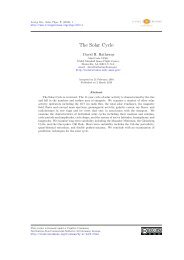PDF (for b&w printout) - Living Reviews in Solar Physics
PDF (for b&w printout) - Living Reviews in Solar Physics
PDF (for b&w printout) - Living Reviews in Solar Physics
You also want an ePaper? Increase the reach of your titles
YUMPU automatically turns print PDFs into web optimized ePapers that Google loves.
The Sun <strong>in</strong> Time: Activity and Environment 21<br />
of such active stars show excessive amounts of plasma around 10 – 20 MK (Güdel et al., 1997b),<br />
which <strong>in</strong>cidentally is the typical range of solar flare temperatures. This aga<strong>in</strong> led to the suggestion<br />
that the high-T emission measure is <strong>in</strong> fact due to the superposition of a multitude of temporally<br />
unresolved flares (see Section 5.8).<br />
4.2.2 Inferences from coronal density measurements<br />
Comprehensive surveys of stellar coronal electron density (ne) measurements based on X-ray spectroscopic<br />
l<strong>in</strong>e-flux ratios were presented by Ness et al. (2004) and Testa et al. (2004), <strong>in</strong>clud<strong>in</strong>g<br />
a sample of active solar analogs. These studies concluded that the surface fill<strong>in</strong>g factor (derived<br />
from the emission measure, the measured ne, and a realistic coronal scale height) of magnetic loops<br />
conta<strong>in</strong><strong>in</strong>g cool X-ray emitt<strong>in</strong>g material <strong>in</strong>creases from <strong>in</strong>active to moderately active stars but then<br />
“saturates” at levels of about ten percent. In the most active stars, hot coronal loops are added,<br />
with a sharply <strong>in</strong>creas<strong>in</strong>g fill<strong>in</strong>g factor, thus probably fill<strong>in</strong>g the volume left between the cooler<br />
coronal magnetic loops. Observations of rotational modulation <strong>in</strong> very active solar analogs suggests,<br />
however, that the coronal volume fill<strong>in</strong>g rema<strong>in</strong>s significantly below 100% (see Section 4.2.3<br />
below).<br />
4.2.3 Inferences from rotational modulation<br />
Inhomogeneous coronae may reveal signatures <strong>in</strong> light curves as the star rotates, although success<br />
of this method has been moderate given that coronal features evolve on time scales shorter than one<br />
rotation (e.g., ow<strong>in</strong>g to flares). Two young, near-ZAMS solar analogs have shown clear signatures<br />
of X-ray rotational modulation (EK Dra, Güdel et al. 1995c, and 47 Cas B, Güdel et al. 1995a),<br />
po<strong>in</strong>t<strong>in</strong>g to a fill<strong>in</strong>g factor below unity. This is unexpected because such stars are <strong>in</strong> the empirical<br />
X-ray saturation regime that has often been suggested to be due to complete fill<strong>in</strong>g of the surface<br />
with X-ray bright coronal magnetic loops (see Section 5.5 below). EK Dra also showed evidence<br />
<strong>for</strong> radio rotational modulation. The depth and length of the modulation (Figure 4a) constra<strong>in</strong>s<br />
the X-ray coronal height, and also the electron densities to ne > 4 × 10 10 cm −3 , <strong>in</strong> agreement with<br />
spectroscopic measurements (Ness et al., 2004). This leads to the conclusion that much of the<br />
emitt<strong>in</strong>g material is concentrated <strong>in</strong> large “active regions”.<br />
Figure 4: Two examples of X-ray rotational modulation <strong>in</strong> young, active solar analogs: Left (a):<br />
EK Dra (Güdel et al., 1995c); right (b): the supersaturated young solar analog VXR45 (Mar<strong>in</strong>o<br />
et al., 2003a). Both light curves are phase-folded (repr<strong>in</strong>ted with permission).<br />
<strong>Liv<strong>in</strong>g</strong> <strong>Reviews</strong> <strong>in</strong> <strong>Solar</strong> <strong>Physics</strong><br />
http://www.liv<strong>in</strong>greviews.org/lrsp-2007-3



